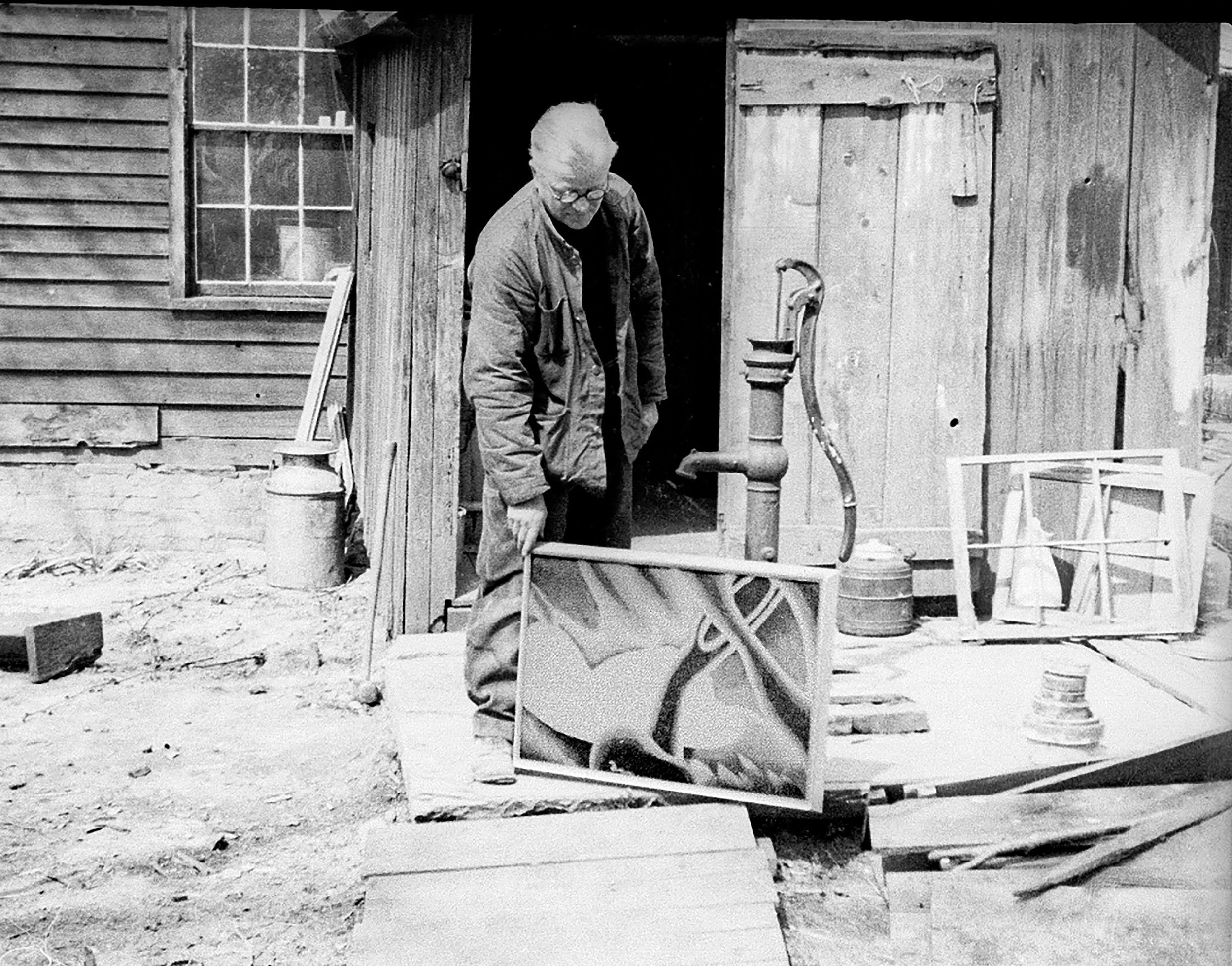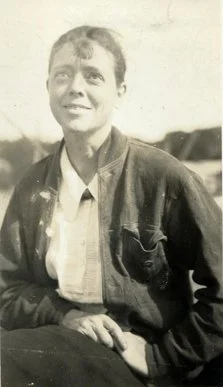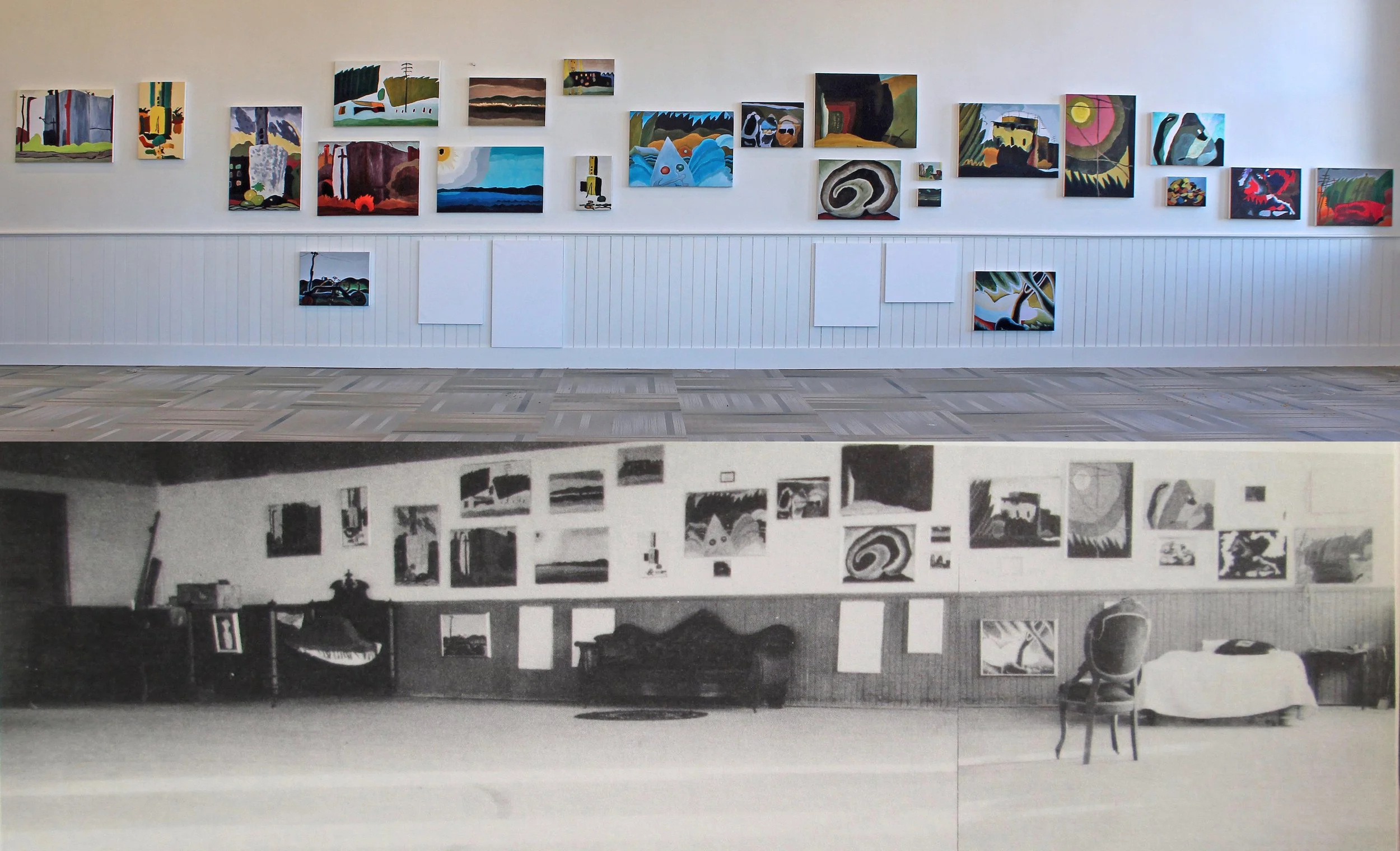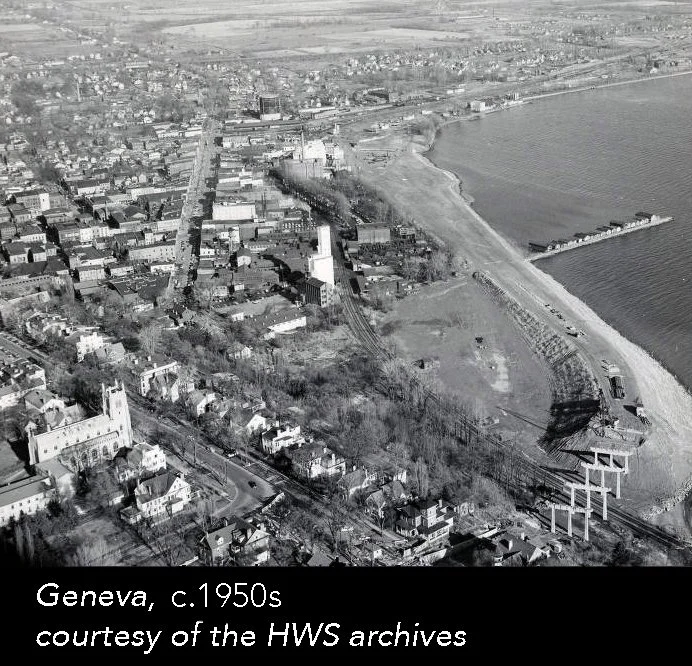Dove’s Life
Arthur Dove with one of his paintings, Geneva, New York, mid-1930s
Arthur Dove (1880-1946), son of the Dove Block’s builder, William Dove, was born in nearby Canandaigua, New York, in 1880, and moved to Geneva when he was two. Growing up in Geneva provided an experience which would fuel his love of nature and his art for the rest of his life. As a child, he was befriended by a neighbor Newton Wetherby, a naturalist who helped form Dove’s appreciation of nature. Weatherby was also an amateur painter who gave Dove pieces of leftover canvas with which to work. He attended Hobart College for two years before moving on to Cornell University in Ithaca, earning his degree in 1903. During his Cornell time, he took courses in painting and drawing. Upon graduation, he began a career as an art illustrator in New York City. Very successful in this capacity, he soon chaffed at the restrictions of the medium and began to feel a need to create art based on his own vision.
Dove and his first wife, Florence, traveled to France and moved to Paris, then the world's art capital. They made short trips to both Italy and Spain. While there, Dove joined a group of experimental artists from the United States, which included Alfred Henry Maurer. Dove and Maurer remained friends until Maurer's suicide in 1932. While in Europe, Dove was introduced to new painting styles, in particular the the Fauvist works of Henri Matisse, and he exhibited at the annual Autumn Salon in 1908 and 1909. Feeling a clearer sense as an artist, he returned to New York.
Returning to New York in 1909, he immediately set to work in this new vein, becoming America’s first abstract painter in the process. His son, William C. Dove, was born on July 4, 1909. Along with his New York friends, photographer Alfred Stieglitz and artist Georgia O’Keeffe, he became, one of the acknowledged founders of “American Modernism”, along with other innovative artists like John Marin, Marsden Hartley, and Thomas Hart Benton. During the mid-1930s, following his mother’s death (his father had died in 1921), and his marriage with Florence now over, he returned to Geneva with his second wife, the artist Helen “Reds” Torr to settle the family estate.
For some time, the couple lived on the nearby family farm while Dove, hoping to make some money in the midst of the Great Depression, tried his hand at various tasks—raising chickens, growing crops. All these eventually proved themselves unsuccessful, which led to Dove accepting the financial support of the art collector, Duncan Phillips (later the founder of the world-famous Phillips Collection in Washington, D.C., which houses the largest collection of Dove’s work in the world. Dove and Torr moved to the third-floor of the Dove Block, which, since the late 1870s, his father had operated as a successful commercial building. The move allowed Dove to concentrate exclusively on his painting and drawing. While residing in the Dove Block, he painted nearly a hundred of what are now seen as his most critically-acclaimed works, including what is perhaps his most famous, “Red Sun”; an abstract vision of the sun rising over Geneva’s Lake Seneca, with the area’s surrounding fields in the foreground.
In 1938, Dove and Torr decided to move to Long Island in order to be closer to the increasingly thriving modern art scene in New York City. There, as his health continued to fail, Dove continued painting until his death in 1946. Torr survived him until 1967.
In the introduction to Arthur Dove: A Retrospective (MIT Press 1998), Dove’s work is characterized as “possess(ing) a radical content that came from the description of intangible elements such as movement, space, and above all, light. These features were suggestive of abstract shapes and lines and quickly developed for the artist [a reputation] that proved international in its scope and practice.” Today, Dove’s paintings are part of the permanent collections of, among many others, The Metropolitan Museum of Art and the Whitney Museum.
Helen S. Torr (1886–1967)
With the recent, intense interest in modernist art, the work of many, often lesser, artists has come to the fore. It is only fitting that Helen Torr's work, long overlooked as the product of a fringe member of the Stieglitz circle, should be reevaluated and recognized for its uniqueness and its quality. In the fecund mix of philosophy and aesthetics of this remarkable group of artists, many pursued similar or overlapping paths, but few followed them as instinctively as Helen Torr. Disregarded by her peers yet viewed as an equal and an inspiration by her husband, Reds produced a distinctive body of work that is informed with her own idiosyncratic style, elegance, and sense of color. Her compelling early abstractions, her carefully painted still lifes of shells and flowers, her rhythmic rolling hills and fields, her inspired harbor front scenes from Huntington, and her accomplished charcoals all testify to a potential that was never fulfilled. It is tragic that, despite Dove's strong advocacy, her abilities were not recognized in her lifetime...It is our great good fortune that her work – all the more precious for the modest number of pieces that she evidently considered worth saving – has survived and can now stand, out of the shadows, on its own merit.
Anne Cohen DePietro, “Out of the Shadows: Helen Torr,” Out of the Shadows: Helen Torr, a Retrospective. Huntington: Heckscher Museum of Art, 2003, p. 39.
Helen S. Torr (1886-1967) was an early American Modernist painter. Known as “Reds” because of her hair color, Torr worked alongside other artists, namely her husband Arthur Dove and friend Georgia O’Keeffe, to develop a characteristically American style of Modernism in the 1920s. Torr was born in Roxbury, Philadelphia in 1886. In 1906, Helen Torr won a scholarship to the Pennsylvania Academy of Fine Arts, where she studied under William Merritt Chase; later, she would go on to study at Drexel University. Her first marriage was to the cartoonist Clive Weed. Torr was reluctant to put her works in exhibitions and found encouragement through her friendships. Most of her work was not shown during her lifetime. Throughout her career, Torr tended to focus on the creation of both oil paintings and charcoal-based drawings.
Torr met fellow artist Arthur Dove in Westport, Connecticut, which resulted in both artists leaving their first marriages. Around 1924, the couple settled aboard a sailboat anchored in Halesite on Long Island. In 1933, they moved to Dove’s hometown, Geneva, New York, where they lived until 1938 when they moved to a cottage in Centerport on Long Island. They lived in the cottage until Dove’ death in 1946. Torr died in Bayshore, Long Island, New York, in 1967.
Torr’s work was exhibited publicly only twice during her life, one of those at Alfred Stieglitz’s gallery, An American Place, in 1933 as part of a group show. Torr outlived Dove by 21 years but never resumed painting, and requested that all her paintings and drawings be destroyed. Instead, her sister donated much of her work to the Heckscher Museum, which organized a show of her work in 1972. In 1980, the Graham Gallery in New York held a solo exhibition of her work. Some of her works are currently held in the Metropolitan Museum of Art and the Boston Museum of Fine Arts. The cottage in which she and Dove resided was acquired in 1998 by the Heckscher Museum of Art in Huntington, New York, and in 2000, was accepted into the Historic Artists’ Homes and Studios Program administered by the National Trust for Historic Preservation.
Dove’s Work
Often heralded as the first American artist to try his hand at abstraction, Dove is perhaps best known for his nature-based abstract paintings, most of which stop short of total non-objectivity. He was one of several American artists actively championed by Stieglitz. Chiefly in the 1920s and 1930s, a group that included John Marin, Marsden Hartley, Charles Demuth, Paul Strand and Georgia O’Keeffe.
The tales of Dove thus told can be divided into three categories, each representing a typical approach to his art: (1) biographical, where Dove’s very interesting life takes precedence over his paintings, the idea being that Dove’s pictures require only abbreviated explanation because they exemplify Stieglitz’s well-defined and vigorously studies ideas about art; (2) genealogical, where Dove is claimed as the first American abstract painter and thus the progenitor, in combination with the European avant-garde, of American abstraction to coe, his career primarily a matter of ingesting and expressing a variety of external sources and influences while setting the stage for Abstract Expressionism in the postwar period; and (3) romantic, where Dove is imagined as an urban-shy anti-modern who retreated to the countryside in order to commune with nature and render his subjective response to the natural world, this individual, emotive, of-the-soil painting being the sort advocated by Stieglitz.
Throughout his career, Dove drew inspiration from the stuff of the observable, material world. And then he distorted, even disfigured this stuff, pushing the majority of his pictures to the cusp of non-objectivity, distorting and inventing without altogether abandoning reference to the real.
Dove’s favoring of the word “sequence,” which by definition entails intentional and particular connections between parts, over “arrangement,” which connotes and an organized group or array but not necessarily the establishing of an essential relationship among components, conveys a concern for the idea of an image as a system, a whole made up of interrelated entities. “Just at present,” he wrote, “I have come to the conclusion that one must have a flexible form or formation that is governed by some definite rhythmic [sic] sense beyond mere geometrical repetition, to express and put in space an idea so that those with sensitive instruments can pick it up, and further that means of expression has to have grown long enough to establish itself as an automatic force.”
Arthur Dove: Always Connect, 2016 by Rachael Z. De Lue
George Gershwin - I'll build A Stairway to Paradise, 1927, Museum of Fine Arts, Boston
The Dove Studio Wall
dedicated to James Spates, Rachael DeLue and Charles Bauder for all their efforts on behalf of The Dove Block Project
gift of The Dove Block Project, Bill Corbett, Chris Ryczek and Matt Sennett
Dove and Torr moved to the third-floor of the Dove Block, which, since the late 1870s, his father had operated as a successful commercial building. The move allowed Dove to concentrate exclusively on his painting and drawing. While residing in the Dove Block, he painted nearly a hundred of what are now seen as his most critically-acclaimed works. The picture above is of the south wall on the third floor of Dove’s studio. The original 1938 photograph is in the Archives of American Art. Tours available.
Arthur Dove Virtual Tour of Geneva
In the 1930s, Geneva, New York, marked a pivotal period in Arthur Dove’s artistic career. Geneva provided Dove with the subject matter for some of his earliest abstractions that came to define his art practice. It was here where Dove gained an understanding for how to merge the intricacies of his mind and imagination with the tactile tools of color and form.
Arthur Dove spent his early years in Geneva, New York, where his father was a brick manufacturer and building contractor. Dove attended Hobart College for two years, starting in 1899, before transferring to Cornell University, where he graduated in 1903.
In January of 1933, Dove returned to Geneva to settle his family’s estate after the death of his mother. He stayed until 1938 with his wife, Helen Torr.
Between 1933 and 1938, Dove produced a vast collection of energetic and sensitive paintings inspired by Geneva. His work captures scenes from his family farm, local barnyard animals, nearby lakes, and industrial features of downtown including warehouses and railroad tracks.
Claire Kapitan, WS‘24
Join us on a tour of Geneva to explore the places that inspired Dove’s work!
Click here to begin the virtual tour at The Dove Block Project.
Are you in Geneva, NY?
Click here for driving instructions to visit the tour sites in person.
Dove’s Paintings

Two Forms, 1931 Oil on board 33 × 24 in. Crystal Bridges Museum of American Art, Bentonville, AR
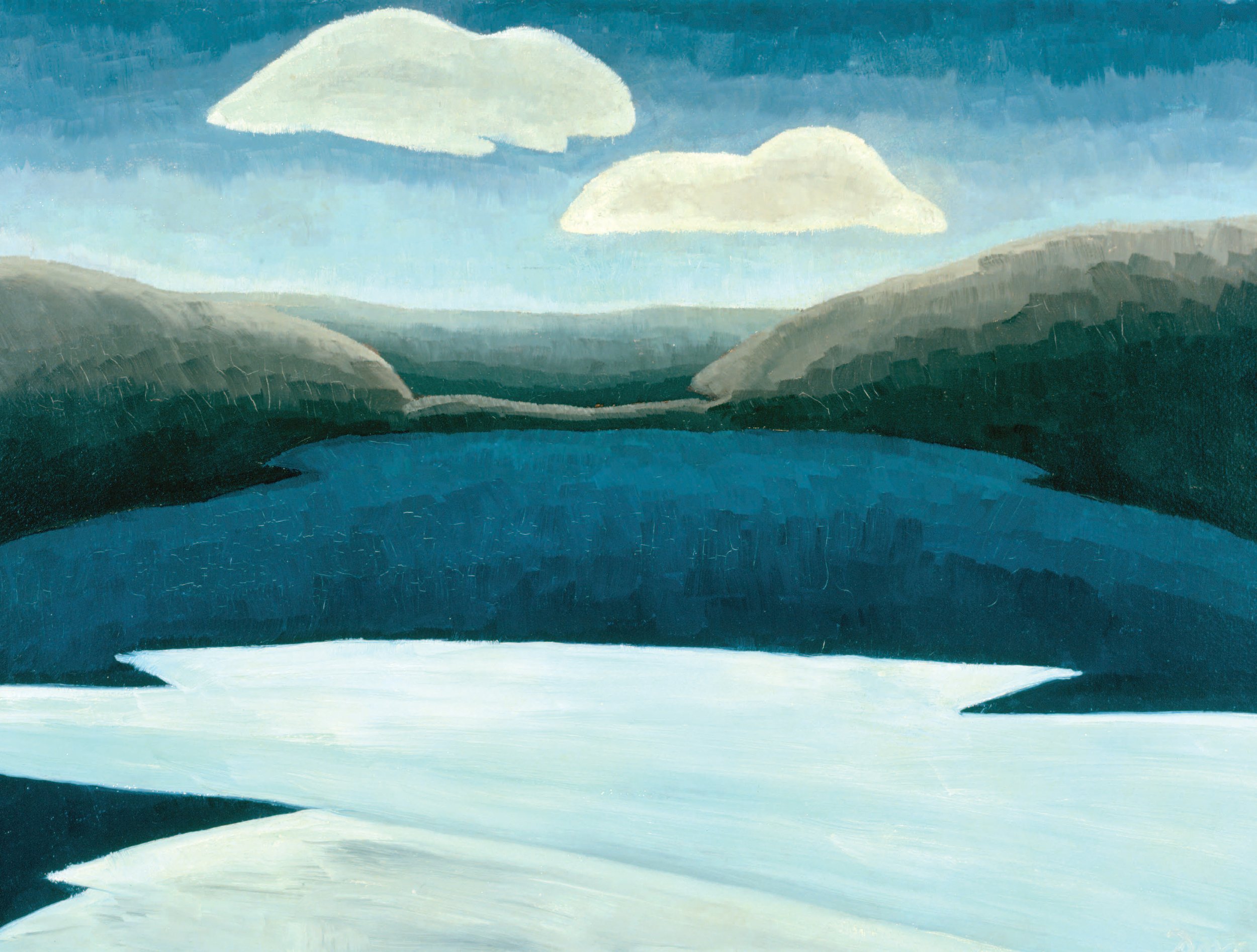
Ice and Clouds, 1931 Oil on board 19 1/2 x 26 3/4 in. Butler Institute of American Art, Youngstown, OH
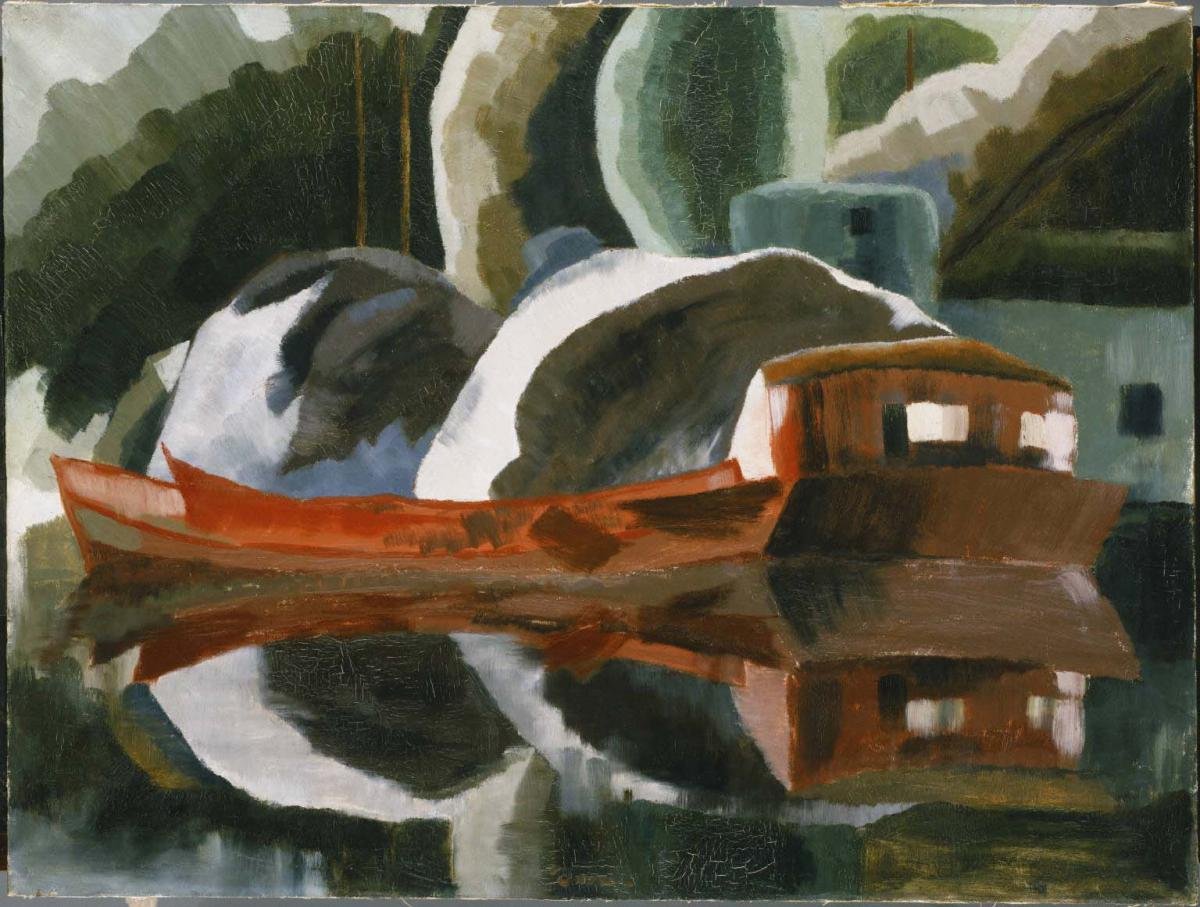
Red Barge, 1931 Oil on canvas 30 x 40 in. The Phillips Collection, Washington, D.C.

Gale, 1932 Oil on canvas 25 3/4 in. x 35 3/4 in. Weisman Art Museum, University of Minnesota, Minneapolis, MN

Trees and Covered Boat, 1932 Oil on canvas 20 x 28 in. Collection of Robert and Arlene Kogod, Memphis, TN

Sun Drawing Water, 1933 Oil on canvas 24 3/8 x 33 5/8 in. The Phillips Collection, Washington, D.C.

Tree Trunks, 1934 Oil on canvas 18 x 24 in. The Phillips Collection, Washington, D.C.

Moon, 1935 Oil on canvas 35 x 25 in. National Gallery of Art, Washington, D.C.

Summer, 1935 Oil on canvas 25 x3 4 in. Museum of Fine Arts Boston, Boston, MA

Morning Sun, 1935 Oil on canvas 20 x 28 in. The Phillips Collection, Washington, D.C.

Naples Yellow Morning, 1935 Oil on canvas 25 1/8 x 35 in. Pennsylvania Academy of the Fine Arts, Philadelphia, PA

Lake Afternoon, 1935 Oil and wax emulsion on canvas 25 x 35 in. The Phillips Collection, Washington, D.C.

Sunrise I, 1936 Oil and wax emulsion on canvas 25 x 35 in. Museum of Fine Arts, Boston, MA

Sunrise III, 1936 Wax emulsion, oil on canvas 25 x 35 1/8 in. Yale University Art Gallery, New Haven, CT
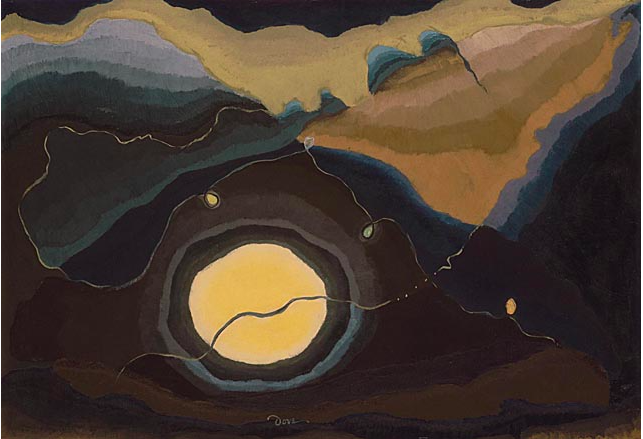
Me and the Moon, 1937 Oil and wax emulsion on Canvas 18 x 26 in. The Phillips Collection, Washington, D.C.

Golden Sun, 1937 Oil on canvas 13 3/4 x 9 3/4 in. Collection of J.R. and Barbara Hyde, Glen Falls, NY

Willow Tree, 1937 Oil on canvas 20 x 28 inches Norton Museum of Art, West Palm Beach, FL

Flour Mill, II 1938 Oil, wax emulsion on canvas 26 1/8 x 16 1/8 in. The Phillips Collection, Washington, D.C.

Cars in a Sleet Storm, 1938 Oil on canvas 15 x 21 in. Memorial Art Gallery, Rochester, NY

Sun on the Lake, 1938 Oil, wax and resin on canvas 22 x 36 in. Museum of Fine Arts, Boston, MA

City Moon, 1938 Oil and wax emulsion on canvas 35 × 25 in. Hirshhorn Museum and Sculpture Garden, Washington, D.C.

Red Sun, 1935 Oil on canvas 20 1/4 x 28 in. The Phillips Collection, Washington, D.C.
Dove’s Works on Paper

Barns, 1932 Watercolor and Ink 7 x 5 in. Private Collection

Oil Boat, 1932 Watercolor and Crayon on Paper 5 x 7 in. Edward T. Pollack Fine Arts, Portland, ME

Canandaigua Outlet, 1934 Watercolor and Crayon on Paper 8.5 x 10.63 in. Private Collection

Patent Cereals, 1935 Watercolor and Pencil on Paper 5.5 x 9 in. Private Collection

Wooded Pond, 1935 Watercolor 5x7 in. The Phillips Collection, Washington, D.C.

Seneca Lake, 1935 Watercolor, Gouache and Ink on paper 5.125 x 7 in. Metropolitan Museum of Art, New York, NY

Canandaigua Outlet, Oakes Corner, 1937 Watercolor on paper mounted on board 5 1/2 x 9 in. Carnegie Museum of Art, Pittsburgh, PA

Study for Woodpile, 1938 Watercolor and ink on paper 4 3/4 x 6 3/4 inches Edward T. Pollack Fin Arts, Portland, ME

Cereal Mill, 1937 Watercolor on Paper 7 x 5 in. Geneva Historical Society, Geneva, NY

Slaughter House, 1937 Watercolor and Ink on Paper 5.38 x 9 in. Bernard Goldberg Fine Arts, East Hampton, NY

St. Peters, 1937 Watercolor on Paper 5 x 7 in. Hobart and William Smith Colleges, Geneva, NY

Sunrise, 1937 Opaque and transparent watercolor and pen and black ink on wove paper 5 x 7 in. (12.7 x 17.8 cm) Wadsworth Atheneum Museum of Art, Hartford, CT

Flour Mill in the Rain, 1938 Watercolor on Paper 7x5 in. Private Collection

Exchange Street II, 1938 Watercolor on Paper 5x5.9 in. Alexander Gallery, New York, NY

Happy Clam Shell, 1938 Watercolor on Ink and Paper 5x7 in. Hobart and William Smith Colleges, Geneva, NY
Torr’s Artwork

January, 1935. The Heckscher Museum of Art; Gift of Mrs. Mary Rehm. Conserved in 2021 through the Adopt a Work of Art Program with funds donated by the Deborah Buck Foundation

From Piano (Music Painting), n.d. The Heckscher Museum of Art; Gift of Mr. William C. Dove. Conserved in 2020 through the Adopt a Work of Art Program with funds donated by Andrea and Neil Kreinik in memory of Andrea's mother, Lillian R. Schwartz, who was an avid classical pianist and music lover for over 90 years

Autumn Leaves, n.d. The Heckscher Museum of Art; Gift of the Baker/Pisano Collection

Geneva Farmhouse, n.d. The Heckscher Museum of Art; Gift of the Baker/Pisano Collection

Cyclamen, n.d. The Heckscher Museum of Art; Gift of Linda Hyman Fine Arts, New York
BOOKS & ARTICLES ON ARTHUR DOVE AND HELEN TORR
Bricker Balken, Debra. Arthur Dove: A Catalogue Raisonne of Paintings and Things. New Haven: Yale University Press, 2021
Pensler, Alan. Arthur Dove: A Reassessment. Seattle: Lucia|Marquand, 2018
DeLue, Rachael Z. Arthur Dove: Always Connect. Chicago and London: The University of Chicago Press, 2016
Out of the Shadows: Helen Torr, a Retrospective. Huntington: Heckscher Museum of Art, 2003
Balken, Debra Bricker. Arthur Dove: a retrospective. Andover, Mass.: Addison Gallery of American Art; Cambridge, Mass.: MIT Press, Massachusetts Institute of Technology in association with the Phillips Collection, Washington, D.C., 1997
Phillips Collection.; Turner, Elizabeth Hutton. In the American Grain: Arthur Dove, Marsden Hartley, John Marin, Georgia O’Keeffe, and Alfred Stieglitz: the Stieglitz Circle at the Phillips Collection. Washington, D.C.: Counterpoint, 1995
DePietro, Anne C. Arthur Dove & Helen Torr: the Huntington Years. Huntington: Heckscher Museum of Art, 1989
Stieglitz, Alfred, Dove, Arthur Garfield, Morgan, Ann Lee. Dear Stieglitz, Dear Dove. Newark: University of Delaware Press ; London; Cranbury, NJ: Associated University Presses, 1988
Cohn, Sherrye. Arthur Dove: Nature as Symbol. Ann Arbor, Mich. : UMI Research Press, 1985
Morgan, Ann Lee. Arthur Dove: Life and Work, with a Catalogue raisonné. Newark : University of Delaware Press ; London : Associated University Presses, 1984
Dove, Arthur Garfield; Phillips, Duncan; Newman, Sasha M. Arthur Dove and Duncan Phillips, Artist and Patron. Washington, D.C.: Phillips Collection; New York, N.Y.: George Braziller, 1981
Gatling Torr, Eva Ingersoll. Helen Torr, 1886-1967. Huntington: Heckscher Museum of Art, 1972

